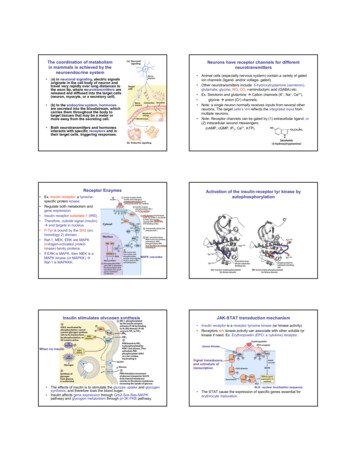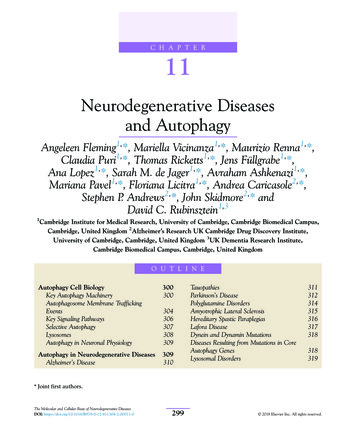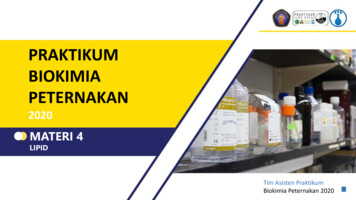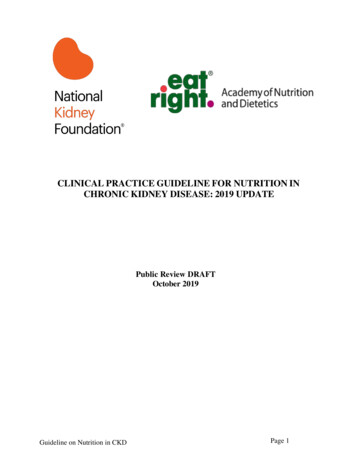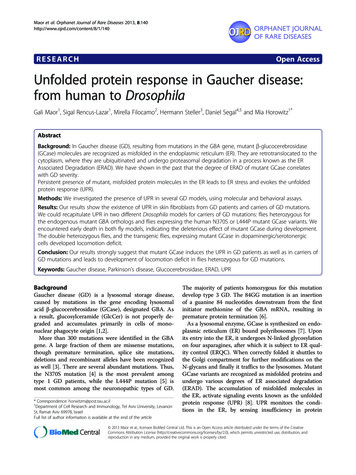
Transcription
Maor et al. Orphanet Journal of Rare Diseases 2013, en AccessUnfolded protein response in Gaucher disease:from human to DrosophilaGali Maor1, Sigal Rencus-Lazar1, Mirella Filocamo2, Hermann Steller3, Daniel Segal4,5 and Mia Horowitz1*AbstractBackground: In Gaucher disease (GD), resulting from mutations in the GBA gene, mutant β-glucocerebrosidase(GCase) molecules are recognized as misfolded in the endoplasmic reticulum (ER). They are retrotranslocated to thecytoplasm, where they are ubiquitinated and undergo proteasomal degradation in a process known as the ERAssociated Degradation (ERAD). We have shown in the past that the degree of ERAD of mutant GCase correlateswith GD severity.Persistent presence of mutant, misfolded protein molecules in the ER leads to ER stress and evokes the unfoldedprotein response (UPR).Methods: We investigated the presence of UPR in several GD models, using molecular and behavioral assays.Results: Our results show the existence of UPR in skin fibroblasts from GD patients and carriers of GD mutations.We could recapitulate UPR in two different Drosophila models for carriers of GD mutations: flies heterozygous forthe endogenous mutant GBA orthologs and flies expressing the human N370S or L444P mutant GCase variants. Weencountered early death in both fly models, indicating the deleterious effect of mutant GCase during development.The double heterozygous flies, and the transgenic flies, expressing mutant GCase in dopaminergic/serotonergiccells developed locomotion deficit.Conclusion: Our results strongly suggest that mutant GCase induces the UPR in GD patients as well as in carriers ofGD mutations and leads to development of locomotion deficit in flies heterozygous for GD mutations.Keywords: Gaucher disease, Parkinson’s disease, Glucocerebrosidase, ERAD, UPRBackgroundGaucher disease (GD) is a lysosomal storage disease,caused by mutations in the gene encoding lysosomalacid β-glucocerebrosidase (GCase), designated GBA. Asa result, glucosylceramide (GlcCer) is not properly degraded and accumulates primarily in cells of mononuclear phagocyte origin [1,2].More than 300 mutations were identified in the GBAgene. A large fraction of them are missense mutations,though premature termination, splice site mutations,deletions and recombinant alleles have been recognizedas well [3]. There are several abundant mutations. Thus,the N370S mutation [4] is the most prevalent amongtype 1 GD patients, while the L444P mutation [5] ismost common among the neuronopathic types of GD.* Correspondence: horwitzm@post.tau.ac.il1Department of Cell Research and Immunology, Tel Aviv University, LevanonSt, Ramat Aviv 69978, IsraelFull list of author information is available at the end of the articleThe majority of patients homozygous for this mutationdevelop type 3 GD. The 84GG mutation is an insertionof a guanine 84 nucleotides downstream from the firstinitiator methionine of the GBA mRNA, resulting inpremature protein termination [6].As a lysosomal enzyme, GCase is synthesized on endoplasmic reticulum (ER) bound polyribosomes [7]. Uponits entry into the ER, it undergoes N-linked glycosylationon four asparagines, after which it is subject to ER quality control (ERQC). When correctly folded it shuttles tothe Golgi compartment for further modifications on theN-glycans and finally it traffics to the lysosomes. MutantGCase variants are recognized as misfolded proteins andundergo various degrees of ER associated degradation(ERAD). The accumulation of misfolded molecules inthe ER, activate signaling events known as the unfoldedprotein response (UPR) [8]. UPR monitors the conditions in the ER, by sensing insufficiency in protein 2013 Maor et al.; licensee BioMed Central Ltd. This is an Open Access article distributed under the terms of the CreativeCommons Attribution License (http://creativecommons.org/licenses/by/2.0), which permits unrestricted use, distribution, andreproduction in any medium, provided the original work is properly cited.
Maor et al. Orphanet Journal of Rare Diseases 2013, 8:140http://www.ojrd.com/content/8/1/140folding capacity and translates this information into geneexpression [9]. The ER membrane harbors three ERstress sensors: The type 1 transmembrane protein kinaseendoribonuclease IRE1, the type 1 protein kinase PERK,and the activating transcription factor 6 (ATF6). Thesethree branches operate simultaneously and use uniquemechanisms of signal transductions. The three UPR transducers are constitutively expressed in metazoan cells [10],and are maintained in an inactive state through interactionwith the ER protein chaperone BiP. Accumulated unfoldedprotein(s) binds and sequesters BiP, thus promoting BiPdissociation from PERK, IRE1 and ATF6. Dissociation ofBiP from the three stress sensors allows their modificationand signal transduction, which results in a response to theaccumulation of misfolded proteins [11]. Thus, IRE1 undergoes dimerization and phosphorylation and participates ina cytoplasmic complex, which splices the transcription factor X-box binding protein 1 (Xbp1). Upon its splicing theXbp1 mRNA is translated into a protein that translocatesinto the nucleus and turns on UPR related genes [9,12,13].PERK is a kinase that undergoes dimerization and autophosphorylation and mediates phosphorylation of theeukaryotic translation initiation factor 2α (eIF2α). Phosphorylated eIF2α attenuates general protein translation inthe cells [9,11,14]. ATF6, the third component among theUPR sensors, shuttles to the Golgi, where it is sequentiallycleaved by proteases. Its cleaved N-terminal cytosolic fragment enters the nucleus where it serves as a transcriptionfactor of UPR upregulated genes, including the induction ofthe proapoptotic bZIP transcription factor CCAAT/enhancer-binding protein homologous protein (CHOP) [15],which is essential for cell cycle arrest and the apoptoticresponse to chronic ER stress [9,11,13,14,16]. Manifestationof UPR in GD derived cells has already been noted in celllines that originated from GD patients, homozygous for theN370S or the L444P mutations [17,18]. Yet, accumulationof glucosylceramide (GlcCer) per se, induced by conduritol-β-epoxide (CBE), did not result in UPR [19]. Likewise, in the absence of mutant GCase there was no UPR[19], underscoring the importance of mutant GCase in theactivation of ERAD and UPR.In this study we tested whether UPR is activated inGD. Our results show the occurrence of UPR in GDderived skin fibroblasts and in carriers of GD mutations,both in humans and Drosophila. In heterozygous flies,and flies expressing the human N370S or L444P mutantGCase variants there were significant developmentaldefects. Locomotion deficit was evident in aging flies,reminiscent of Parkinson disease (PD).Materials and methodsMaterialsThe following primary antibodies were used in this study:rabbit polyclonal anti-GRP78 antibodies (Cell SignalingPage 2 of 14Technology, Beverly, MA, USA), mouse monoclonal antiCHOP antibody (Cell Signaling Technology, Beverly, MA,USA), rabbit polyclonal anti-phospho-eIF2α (Ser51) antibodies, rabbit polyclonal anti-eIF2α antibodies (from cellsignaling Technology, Beverly, MA, USA), mouse monoclonal anti-actin antibody (Sigma-Aldrich, Israel), rabbitpolyclonal anti human GCase antibodies (Sigma-Aldrich,Israel) and mouse monoclonal anti-tubulin antibody(Sigma-Aldrich, Israel).Secondary antibodies used were: horseradish peroxidaseconjugated goat anti-mouse antibodies and Horseradishperoxidase-conjugated goat anti-rabbit antibodies (bothfrom Jackson Immuno Research Laboratories, WestGrove, PA, USA). Leupeptin, phenylmethylsulfonyl fluoride (PMSF) and aprotinin were from Sigma–Aldrich(Rehovot, Israel). Absolute Blue qPCR SYBR Green ROXMix was from Thermo Scientific (Logan, UT, USA).Cell linesHuman primary skin fibroblasts were provided by twopublically available, sources: by “Cell Line and DNABiobank from Patients Affected by Genetic Diseases”(G. Gaslini Institute), Telethon Genetic Biobank for GDskin fibroblasts or by Prof. R. O. Brady, NIH. The patients signed an informed consent. Work with the celllines was in accordance with the institutional guidelinesof Tel Aviv University. Identifiable clinical and personaldata from the patients were not available for this study.Cells were grown in DMEM supplemented with 20%FBS (Biological Industries, Beit Haemek, Israel). All cellswere grown at 37 C in the presence of 5% CO2.Fly strainsCanton-S flies (WT) served as a wild-type control.Strains were maintained on cornmeal-molasses medium at 25 C. Strains harboring a minos transposableelement in CG31414 [Mi{ET1}CG31414] or in CG31148[Mi{ET1}CG31148] were from the Bloomington Stock Center (#23602 and #23435, respectively). Da-Gal4 and DdcGal4 driver lines were obtained from Bloomington StockCenter. Transgenic flies, harboring pUASTmycHisGCase,pUASTmycHisN370SGCase or pUASTmycHisL444PGCaseon the second chromosome, were established by BestGene(Chino Hills, CA, USA).MethodsConstruction of plasmidsAn XbaI-SapI fragment, isolated from pcDNA4 (InvitrogenLife Technologies Co., Carlsbad, CA, USA) was subclonedbetween XbaI and SapI restriction sites of pUAST, tocreate pUASTmycHis. EcoRI-XhoI fragments, containingeither the normal or the N370S or the L444P mutanthuman GCase cDNAs, isolated from the plasmids MycHisWT GCase, MycHis N370S GCase or MycHis L444P
Maor et al. Orphanet Journal of Rare Diseases 2013, 8:140http://www.ojrd.com/content/8/1/140GCase [20], respectively, were subcloned in pUASTmycHis, cleaved with the same restriction enzymes, to createpUASTmycHisGCase, pUASTmycHisN370SGCase orpUASTmycHisL444PGCase, respectively.RNA preparationTotal RNA was isolated using EZ-RNA kit (BiologicalIndustries, Beit Haemek, Israel), according to the manufacturer’s instructions. For RNA extraction from flies,adult flies were frozen in liquid nitrogen and thenhomogenized in TRI Reagent solution (MRC, Cincinnati,Ohio, USA). The extraction was performed according tothe manufacturer’s recommendations.RT PCRTwo μg of RNA were reverse transcribed with M-MLVreverse transcriptase (Promega Corporation, CA, USA),using oligo dT primer in a total volume of 20 μl, at 42 Cfor 60 minutes. Reactions were stopped by incubation at70 C for 15 minutes. One-two microliters of the resulting cDNA were amplified by PCR or by quantitativereal time PCR.PCRPCR was executed in 25 μl containing 0.4 mM dNTPs,10 ρM of each primer, 1 unit of Taq polymerase (Takara,Shiga, Japan) and 10 Taq buffer (10 mM Tris HCLpH 8.3, 50 mM KCl and 1.5 mM MgCl2). Thirty cyclesof 94 C (1 minute), 58 C (1 minute) and 72 C (1 minute)were performed, following by 10 minutes at 72 C forfinal extension. PCR reactions were carried out in anEppendorff Master-cycler EP Gradient S (Eppendorf,Hamburg, Germany). PCR products were separated byagarose gel electrophoresis (1–1.5%) and visualized with0.1% ethidium bromide. Sequence of the primers usedappears in Table 1.Quantitative real time PCROne μl of cDNA was used for quantitative real timePCR. PCR was performed using “power SYBR greenQPCR mix reagent kit” (Applied Biosystems, Foster City,CA, USA) by Rotor-Gene 6000 (Qiagen, Valencia, CA,USA). The reaction mixture contained 50% QPCR mix,300 nM of forward primer and 300 nM of reverseprimer, in a final volume of 10 μl. Thermal cycling conditions were 95 C (10 minutes), and 40 cycles of 95 C(10 seconds) 60 C (20 seconds) and 72 C (20 seconds).Relative gene expression was determined by Ct value.Human cDNA was amplified with primers specific forhuman BiP (Human-GRP78-RT-F and Human-GRP78RT-R, Table 1) or human CHOP (Human-CHOP-RT-Fand Human-CHOP-RT-R, Table 1). GAPDH was used asa normalizing control for human genes (amplified withprimers: Human-GAPDH-RT-F and Human-GAPDH-Page 3 of 14Table 1 Primers used in this ��-GGGCATCAGATATTGTCCCT-3′The table contains the sequence of all the primers used in this work.RT real time, R reverse, F forward.RT-R, Table 1). Amplification of Drosophila genes wasconducted with primers specific for Drosophila Hsc-70-3(Drosophila-Hsc-70-3-RT-F and Drosophila-Hsc-70-3RT-R, Table 1), or for the spliced form of DrosophilaXbp1 (Drosophila-s-Xbp1-RT-F and Drosophila-s-Xbp1RT-R, Table 1). RP49 was used as a normalizing control(amplified with primers: Drosophila RP49-RT-F andDrosophila RP49-RT-R, Table 1).Detection of spliced Xbp1 mRNA processingHuman spliced Xbp1 was amplified from cDNA using theprimers: Human s-Xbp1 F and Human s-Xbp1-R (Table 1).GAPDH was used as a normalizing control (amplifiedwith primers: Human-GAPDH-F and Human-GAPDH-R,Table 1). To amplify Drosophila spliced Xbp1 the primers:Drosophila s-Xbp1-RT-F and Drosophila s-Xbp1-RT-R(see Table 1) were used, with Drosophila RP49 as a normalizing control. The forward primer could anneal only tothe spliced form of Xbp1 mRNA.SDS-PAGE and western blottingCultured cellsCell monolayers were washed three times with ice-coldphosphate-buffered saline (PBS) and lysed at 4 C in lysisbuffer (10 mM HEPES pH 8.0, 100 mM NaCl, 1 mMMgCl2 and 1% Triton X-100) containing 10 μg/ml aprotinin, 0.1 mM phenylmethylsulfonyl fluoride (PMSF) and10 μg/ml leupeptin. Lysates were incubated on ice for30 minutes and centrifuged at 10,000 g for 15 minutesat 4 C.
Maor et al. Orphanet Journal of Rare Diseases 2013, 8:140http://www.ojrd.com/content/8/1/140FliesFor each preparation, 10 flies were homogenized in RIPAlysis buffer (50 mM Tris/HCL, 150 mM NaCl, 1 mMEDTA, 1% TritonX-100, 1% sodiumdeoxycholate, 0.1%SDS) containing protease inhibitors (10 μg/ml leupeptin,10 μg/ml aprotinin and 0.1 mM PMSF- all from SigmaAldrich, Israel). Samples containing the same amount ofprotein were electrophoresed through 10% SDS–PAGEand electroblotted onto a nitrocellulose membrane(Schleicher and Schuell BioScience, Keene, NH, USA).Further treatment of membranes and ECL detection wasas described elsewhere [21].Enzymatic activityConfluent primary skin fibroblasts were washed twice withice-cold PBS and collected with a rubber policeman in150 μl sterile water. Cell lysates, containing 40 μg of protein, were assayed for GCase activity in 0.2 ml of 100 mMpotassium phosphate buffer, pH 4.5, containing 0.15%Triton X-100 (Sigma-Aldrich, Israel) and 0.125% taurocholate (Calbiochem, La Jolla, CA, USA) in the presenceof 1.5 mM 4-methyl-umbeliferyl-glucopyranoside (MUG)(Genzyme Corporation. Boston, MA, USA) for 1 h at 37 C.The reaction was stopped by the addition of 0.5 ml of stopsolution (0.1 M glycine, 0.1 M NaOH, pH 10) and theamount of 4-methyl-umbeliferone (4-MU) was quantifiedusing Perkin Elmer Luminescence Spectrometer LS 50(excitation wavelength: 340 nm; emission: 448 nm) [22].Endonuclease-H (endo-H) treatmentSamples of cell lysates, containing 100 μg of total protein, were subjected to an overnight incubation withendo-H (New England Biolabs, Beverly, MA, USA),according to the manufacturer’s instructions. They wereelectrophoresed through 10% SDS-PAGE and the corresponding blot was interacted with anti GCase and antiactin antibodies. Total GCase amount was divided bythat of actin at the same lane and normalized to WTGCase, which was considered 100. To determine theendo-H resistant fraction, the intensity of GCase resistant fraction was divided by the intensity of the entireamount of GCase in the same lane. GDPV (GD Predictive Value) was determined as described elsewhere [23](GCase amount X GCase resistant fraction: 100).Climbing assay of fliesVials, each containing 10 male flies, were tapped gentlyon the table and left standing for 15 seconds. The number of flies that climbed at least five cm was recorded.The experiment was repeated 10 times.Page 4 of 14and the intensity of each band was measured by theImage Master 1DPrime densitometer (AmershamPharmacia Biotech, Buckinghamshire, England) andGelQuant (BiochemLabSolutions).StatisticsAll the results were statistically analyzed using thestudent t-test.ResultsActivation of UPR in GD derived fibroblastsMutant GCase is recognized as misfolded in the ER.After several unsuccessful attempts to refold it, it undergoes ERAD [21]. The level of ERAD correlates with GDseverity, since it determines the amount of mutantenzyme that reaches the lysosomes and degrades thesubstrate there, depending on its residual activity. Moreover, skin fibroblasts that derived from GD patientshomozygous for the N370S or the L444P mutationsexhibited UPR [17,24]. We, therefore, decided to extendthe study and tested whether UPR is activated in additional GD derived cells. The UPR induces increasedtranscription of the molecular chaperone BiP and thetranscription factor CHOP [25]. In addition, the UPRinduces splicing of the Xbp1 transcript and phosphorylation of eIF2α [25].Based on the above, we first examined the activationof UPR in GD by testing mRNA levels of BiP and CHOPin skin fibroblasts obtained from GD patients. To do so,we used the quantitative RT-PCR approach, usingnormal fibroblasts as control. Our results, (Figure 1A),showed a significant increase in BiP and CHOP mRNAlevels in GD derived fibroblasts, compared to normalcells. A concomitant increase was detected in the protein levels of BiP and CHOP (Figure 1B-D).In GD, there is accumulation of the GCase substrateGlcCer, along with the presence of mutant GCase, whichundergoes ERAD. In order to test possible contributionof substrate accumulation to UPR, we induced substrateaccumulation using the non-competitive inhibitor ofGCase, CBE, for 10 days, as has done by Farfel et al.[19]. It has already been shown in the past that CBEtreatment leads to substrate accumulation in skin fibroblasts [26]. Treatment of normal skin fibroblasts with200 μM CBE, which completely abolished GCase activity, (Additional file 1: Figure S1A) did not induce elevation in mRNA levels of either BiP or CHOP (Additionalfile 1: Figure S1B). Thus, substrate accumulation in GDderived fibroblasts does not activate the UPR.Blot quantitationSplicing of Xbp1 as a UPR marker in GD derivedfibroblastsThe blots were scanned using Image Scan scanner(Amersham Pharmacia Biotech, Buckinghamshire, England),Splicing of Xbp1 is a central hinge of the IRE1 pathway[25,27], which is another branch activated in the UPR.
Maor et al. Orphanet Journal of Rare Diseases 2013, 8:140http://www.ojrd.com/content/8/1/140Page 5 of 14Figure 1 Elevation in CHOP and BiP levels in GD derived cells. A. RNA was isolated from different GD derived skin fibroblasts, and thecorresponding cDNA was used for quantitative RT-PCR with primers specific for human BiP or CHOP. GAPDH was used as a normalizing control.Two different normal cell lines were used as control. Dark box: CHOP; Light box: BiP. B, C. Protein lysates were prepared from different GDderived skin fibroblasts and subjected to western blotting. The corresponding blots were interacted with anti BiP (B) and anti CHOP (C)antibodies. As a loading control, the blots were interacted with anti-tubulin antibody. For each protein there are two blots, each with a normalcontrol. This is due to the fact that cell lysates were prepared at different times, depending on the growth rate of the cell lines and, therefore, ranon different gels. The genotypes for B and C are shown in D. D. The blots were quantified as explained. The amount of BiP and CHOP wasdivided by that of tubulin in the same lane, and the values obtained for normal cells were considered 1. The results are the mean (minus plusstandard error) of three different experiments. Significance: * 0.05; ** 0.01.The Xbp1 mRNA contains two overlapping readingframes, A and B. Under normal conditions, only A frameis transcribed, producing an unspliced version of Xbp1with no protein product (see Figure 2A) [28]. Upon UPRactivation, IRE1 dimerizes and participates in cytoplasmic splicing of Xbp1, thus, removing a 26 bp intronfrom the Xbp1 mRNA. The spliced Xbp1 mRNA (frameB) encodes a transcription factor that binds to the UPREor ERSE consensus sequences of promoters of UPRtarget genes, thus leading to their transcription [28].Expression of spliced Xbp1 in GD derived skin fibroblasts was tested (see Figure 2B). Our results, presentedin Figure 2B, showed that in GD derived fibroblasts thespliced Xbp1 product was significantly elevated, in comparison to normal fibroblasts.eIF2α is a subunit of eIF2, a heterotrimeric GTPase,required to bring the initiator methionyl-tRNA to the40S ribosomal subunit for AUG initiation codon selection. Phosphorylation of eIF2α inhibits the GDP/GTPexchange reaction on eIF2, thus preventing eIF2 recycling and its initial step of protein synthesis [9]. Phosphorylated eIF2α attenuates general protein translationin cells [9,11,14]. We therefore tested possible changesin the levels of phosphorylation of eIF2α, using westernblotting and interaction with anti-phosphorylatedeIF2α antibodies. Our results, presented in Figure 2D, E,showed that eIF2α phosphorylation was increased inGD derived fibroblasts in comparison to normalfibroblasts.Activation of UPR in carriers of GD mutationsElevation in phosphorylation of eIF2α in GD derivedfibroblastsDissociation of PERK from BiP leads to its dimerizationand autophosphorylation, and mediates phosphorylationof the eukaryotic translation initiation factor 2α (eIF2α).Our results strongly suggested that UPR results from thepresence of mutant GCase in the cells, since substrateaccumulation by itself did not lead to activation of theUPR machinery. To confirm our observations wedecided to investigate the occurrence of UPR in cells
Maor et al. Orphanet Journal of Rare Diseases 2013, 8:140http://www.ojrd.com/content/8/1/140Page 6 of 14Figure 2 Elevation in Xbp1 splicing and eIF2α phosphorylation in GD derived cells. A. Scheme showing the two Xbp1 RNA variants, thespliced and the non-spliced forms. B. RNA was isolated from different GD derived skin fibroblasts, and the cDNA prepared from it was used forRT-PCR, with primers specific for the spliced form of human Xbp1. GAPDH was used as a normalizing control. C. The results (three differentexperiments) were quantified and the amount of Xbp1 was divided by that of GAPDH in the same lane. The values obtained for normal cellswere considered 1. D. Protein lysates were prepared from different GD derived skin fibroblasts and subjected to western blotting. Thecorresponding blots were interacted with anti phosphorylated eIF2α (p-eIF2α) and as a loading control, with anti eIF2α antibodies. E. p-eIF2αamount was divided by that of eIF2α in the same lane, and the values obtained for normal cells were considered 1. The results are the mean(minus plus standard error) of three different experiments. Significance: * 0.05; ** 0.01. The genotypes for B and D are shown in C andE, respectively.derived from carriers of different GD mutations. To thisend we tested elevation in BiP and CHOP mRNA, inXbp1 splicing and in phosphorylation of eIF2α in cellsthat derived from carriers of several GD mutations. Ourresults, presented in Figure 3, showed a significant elevation in the amount of BiP and CHOP mRNAs as well asin Xbp1 splicing in carriers of GD mutations. Likewise,phosphorylation of eIF2α increased significantly in cellsthat originated from carriers in comparison to normalcells. Interestingly, we observed activation of UPR alsoin cells carrying the 84GG mutation, strongly suggestingthat existence of a mutant GBA mRNA evokes UPR.Activation of UPR in Drosophila GD-like carriersThere are two GBA homologs in Drosophila, designatedCG31414 and CG31148, both encoding proteins showing 31% identity and 49% similarity to the humanGCase. Two Drosophila strains are available, each carrying a minos transposable element insertion in one of thefly GBA orthologs. Insertion of minos in the CG31414gene leads to translation of truncated GCase, lacking129 C-terminal amino acids (out of the 448 amino acidsof the predicted normal fly GCase protein). The minosinsertion in CG31148 leads to a truncated proteinlacking 34 C-terminal amino acids. Due to their closeproximity on chromosome 3, simple genetic manipulations cannot be employed to create a chromosome withboth mutated genes. However, double heterozygous fly isan authentic model for the GD carrier state in human.We generated double heterozygous flies, which exhibited 30% decrease in GCase activity, as expected(Figure 4A). We then tested possible activation of UPRin these flies. The fly does not contain a CHOP homolog in its genome and UPR activation is measured byelevation in mRNA of the BiP ortholog heat-shockcognate 70–3 (Hsc-70-3 gene), in level of Xbp1 splicingand in the level of phosphorylated eIF2α. We observeda significant elevation in the level of Hsc-70-3 mRNAand Xbp1 splicing in the double heterozygotes, as wellas in phosphorylation of eIF2α (Figure 4), compared toWT flies. These results clearly point to existence ofUPR in carriers of mutations in the GBA orthologs of
Maor et al. Orphanet Journal of Rare Diseases 2013, 8:140http://www.ojrd.com/content/8/1/140Page 7 of 14Figure 3 Activation of UPR in carriers of GD mutations. A. RNA was isolated from skin fibroblasts that originated from carriers of GDmutations, and the corresponding cDNA was used for quantitative RT-PCR with primers specific for human BiP or CHOP. GAPDH was used as anormalizing control. B. cDNA, prepared as in (A), was subjected to RT-PCR, with primers specific for the spliced form of human Xbp1. GAPDH wasused as a normalizing control. C. The results (three different experiments) were quantified as explained in the legend to Figure 2 and the valuesobtained for normal cells were considered 1. D. Protein lysates, prepared from the above-mentioned cells, were subjected to western blottingand interaction with anti phosphorylated eIF2α antibodies (p-eIF2α). As a loading control, the blots were interacted with anti eIF2α antibodies.E. The results (three different experiments) were quantified as explained in the legend to Figure 3B, and the values obtained for normal cellswere considered 1. There are two blots, each with a normal control. This is due to the fact that cell lysates were prepared at different times,depending on the growth rate of the cell lines and, therefore, ran on different gels. Significance: * 0.05; ** 0.01; *** 0.005. The genotypes forB and D are shown in C and E, respectively.Drosophila. A significant defect in development fromlarva to pupa and from pupa to adult was found in thedouble heterozygous animals, in comparison to WTDrosophila (Figure 4E). This highlights the significanceof normal GCase during development and the deleterious effect of mutant GCase.We also ectopically expressed the N370S or the L444Phuman mutant GCase variants in the fly, using the Gal4/UAS system. In this system the yeast Gal4 transcriptionfactor, expressed from a tissue specific Drosophila promoter, is used to express a specific transgene (in ourcase, the human normal or mutant mycHis taggedGCase cDNAs) coupled to the yeast UAS. Thus, expression of the transgene depends on the specificity of thepromoter used for the expression of the Gal4 transcription factor. We used daughterless-Gal4, which drivesubiquitous expression of the transgene. We verifiedexpression of the transgene using western blotting andinteraction with anti myc antibody (Figure 5A). Theresults showed expression of the normal human as wellas the mutant proteins in the transgenic flies. Incomparison to the normal human protein expressed inthe fly, the N370S or the L444P mutant variantspresented higher endo-H sensitivity (Figure 5A)[21,29,30], illustrating the existence of ERAD of mutanthuman GCase in the flies. The fraction of lysosomalN370S human GCase, (endo-H resistant fraction, labeledby black circles in Figure 5A) was higher than that ofL444P human GCase, as expected for these two mutations and shown for endogenous human N370S andL444P mutant GCase variants [21,29]. Furthermore, theresults (Figure 5B-D) demonstrated higher activation ofthe UPR in flies expressing the mutant variants thanthose expressing the WT human GCase. UPR was measured by increase in the mRNA levels of Hsc-70-3, inthe mRNA levels of spliced Xbp1 and in the levels ofphosphorylated eIF2α.A significant defect in development from larva to pupaand from pupa to adult was found in animals expressingthe human mutant GCase variants, in comparison toanimals expressing the WT human GCase (Figure 5E),similar to the double heterozygous flies. This highlights
Maor et al. Orphanet Journal of Rare Diseases 2013, 8:140http://www.ojrd.com/content/8/1/140Page 8 of 14Figure 4 UPR activation in Drosophila carriers of mutant GBA orthologs. A. GCase activity was tested in protein lysates prepared from eitheradult wild type (Canton S, WT) flies or from males and females of double heterozygous flies ng 4-MUG as a substrate. Presented are results of three experiments. B. RNA was isolated from double heterozygous flies, and the cDNAprepared from it was subjected to quantitative RT-PCR with primers specific for Drosophila Hsc-70-3 or for the spliced form of Drosophila Xbp1.The results (three different experiments) were quantified as explained in the legend to Figure 1A, and the values obtained for WT flies wereconsidered 1. RP
PCR products were separated by agarose gel electrophoresis (1-1.5%) and visualized with 0.1% ethidium bromide. Sequence of the primers used appears in Table 1. Quantitative real time PCR One μl of cDNA was used for quantitative real time PCR. PCR was performed using "power SYBR green QPCR mix reagent kit" (Applied Biosystems, Foster City,



